April 26 and 27 mornings: Moon near Antares
Watch for the waning moon to rise in the depths of night tonight (night of April 26-27, 2024). No matter where you are on Earth’s globe, it should be over your horizon by midnight or shortly thereafter. By tomorrow morning (April 27), you’ll easily see the moon close to the bright star Antares, Heart of the Scorpion in Scorpius.
Our charts are mostly set for the northern half of Earth. To see a precise view – and time – from your location, try Stellarium Online.
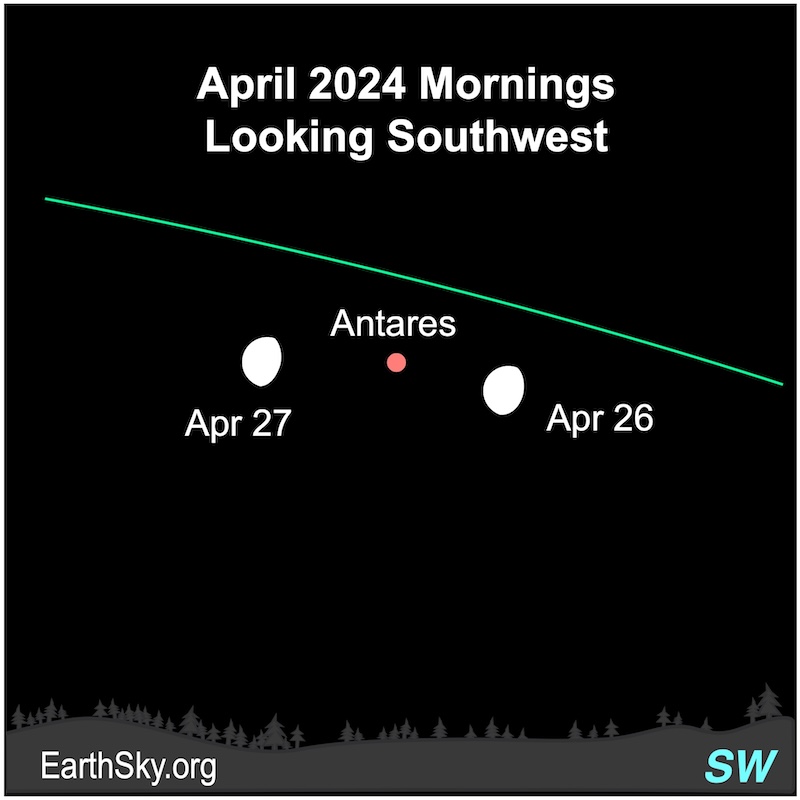
Glorious shot of last week’s full moon
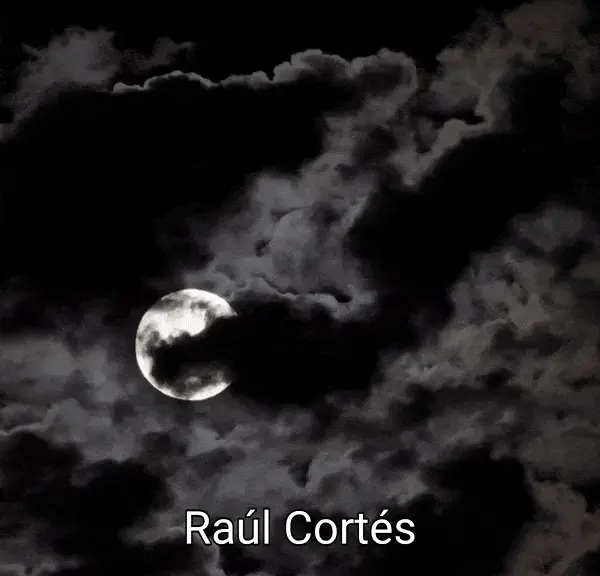
May 1: Last quarter moon
The instant of last quarter moon will fall at 11:27 UTC (6:27 a.m. CDT) on May 1, 2024. It’ll rise after midnight your local time, and will set around noon. Look for it high in the sky before dawn.
May 3 and 4 mornings: Moon near Saturn and Mars
Before dawn on May 3 and 4, 2024, the waning crescent moon will float near Saturn and Mars. On May 3, the lit portion of the moon will point toward Saturn. Then on the morning of May 4, the lit portion of the moon will point to Mars. Also, skywatchers in Antarctica will see the moon pass in front of – or occult – Saturn near 2 UTC on May 5.
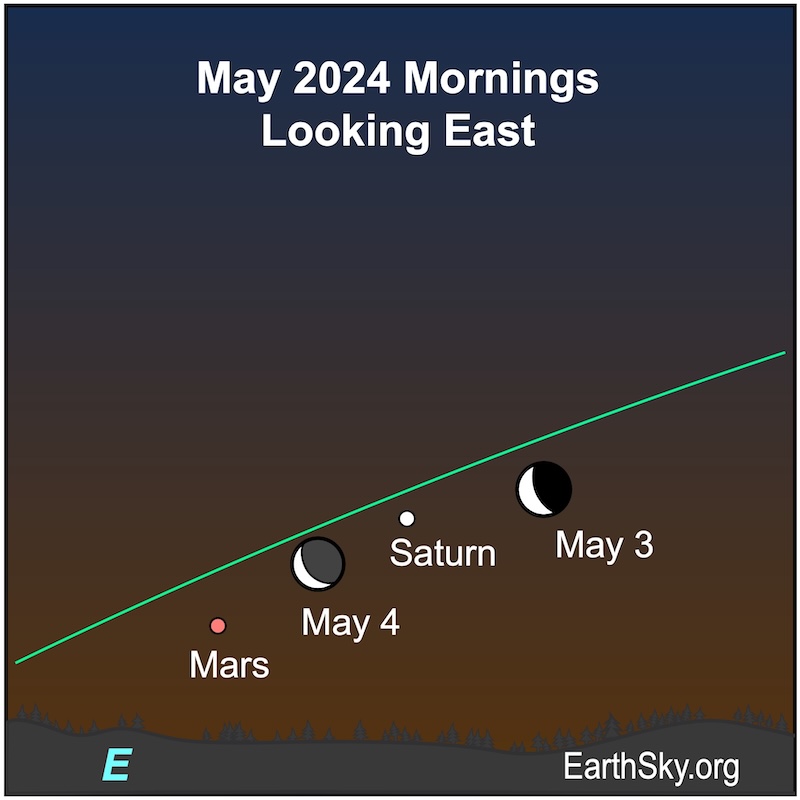
Our charts are mostly set for the northern half of Earth. To see a precise view – and time – from your location, try Stellarium Online.
May 5: Moon reaches perigee
The moon will reach perigee – its closest point in its elliptical orbit around Earth – at 22 UTC (5 p.m. CDT) on May 5, 2024, when it’s 225,659 miles (363,163 kilometers) away.
May 5 morning: Moon near Mars and Saturn
Before sunrise on May 5, 2024, the waning crescent moon will lie near Mars. And Saturn will be higher on the sky’s dome. Do you notice a lovely glow on the unlit side of the moon? That’s earthshine! It’s reflected light from the Earth.
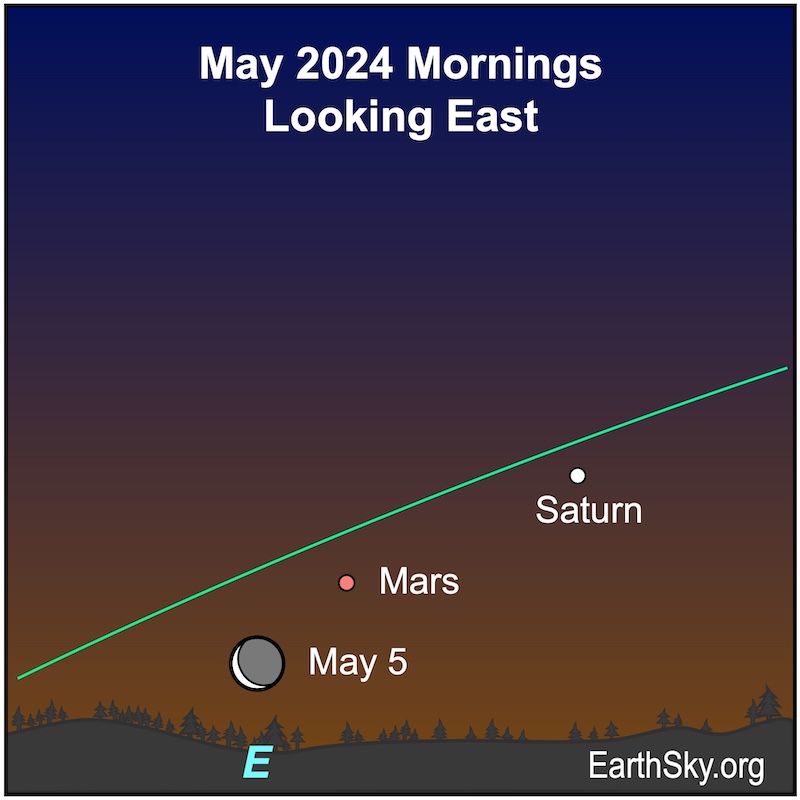
Before dawn May 5 and 6: Eta Aquariid meteor shower
The best time to watch the Eta Aquariid meteor shower will be before dawn on May 5 and 6, 2024. With the new moon a few days away, there won’t be any moonlight to hinder meteor watching. Under ideal conditions, you might see around 20 meteors per hour.
May 6 morning: Moon near Mercury
In the morning twilight on May 6, 2024, a slender waning crescent moon will lie near Mercury. They’ll both lie low on the horizon; binoculars might help locate them. Reddish Mars will be higher in the sky. Also, look for a lovely glow on the unlit side of the moon. That’s reflected light from the Earth called earthshine!

May 8: New moon
The instant of new moon will fall at 3:22 UTC on May 8, 2024 (10:22 p.m. CDT on May 7). That night is a perfect time for stargazing under dark skies.
May 9: Mercury at greatest morning elongation
Mercury reaches its greatest elongation – 26 degrees – from the morning sun at 22 UTC (5 p.m. CDT) on May 9, 2024.
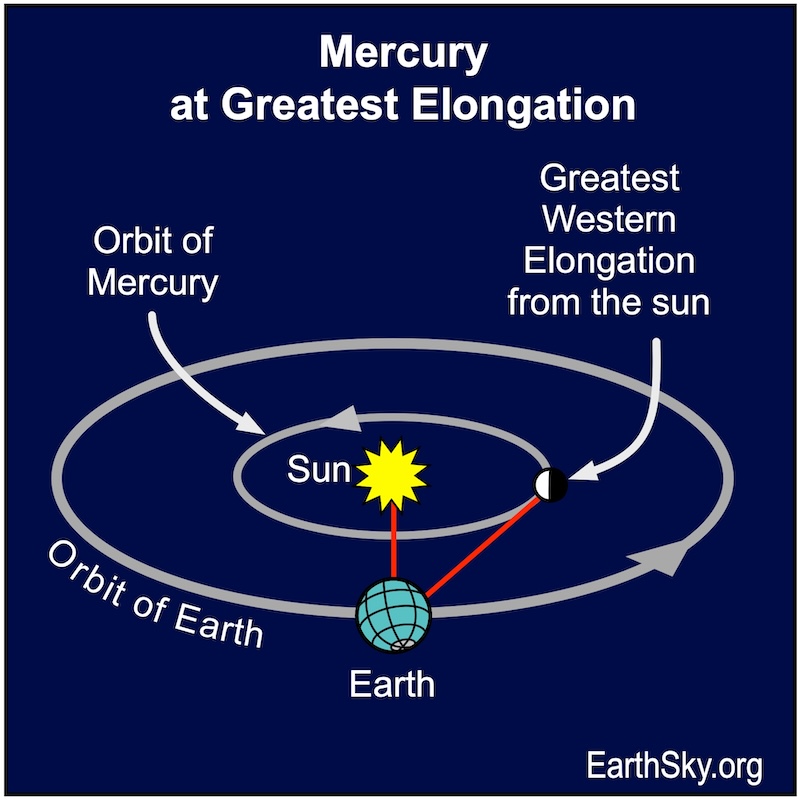
Our charts are mostly set for the northern half of Earth. To see a precise view – and time – from your location, try Stellarium Online.
May 10 evening: Moon between Capella and Betelgeuse
On the evening of May 10, 2024, the waxing crescent moon – glowing with earthshine – will lie between two bright stars. The golden star is Capella in the constellation Auriga the Charioteer. And in vivid contrast to golden Capella is the bright red supergiant star Betelgeuse, the brightest star in Orion the Hunter. You can follow them until almost midnight.
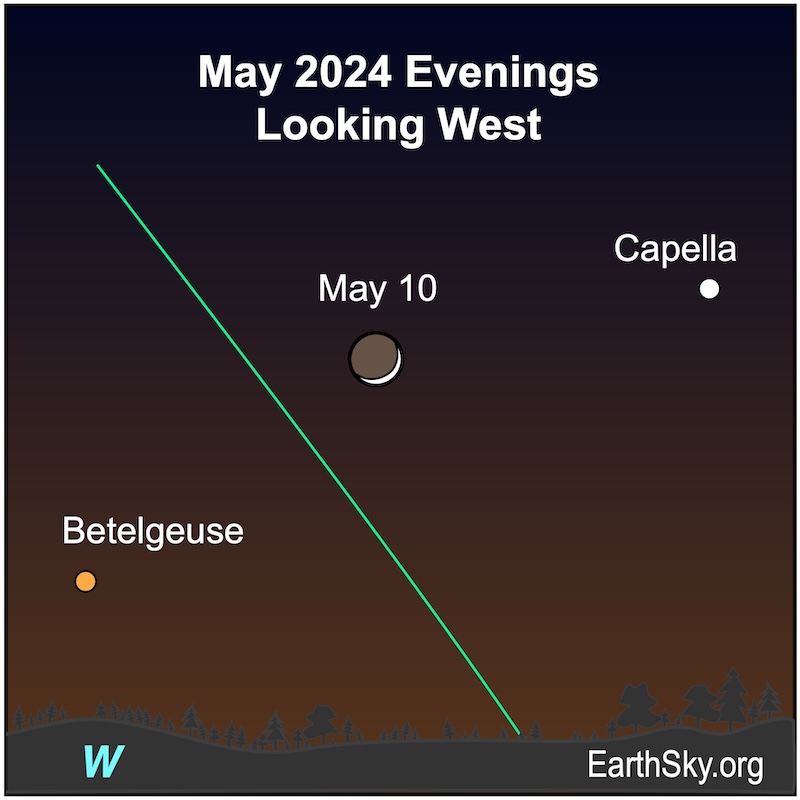
May 12 evening: Moon close to the twin stars of Gemini
On the evening of May 12, 2024, the waxing crescent moon will shine near Pollux and Castor, the twin stars of Gemini. Even though they are known as twins, they really don’t look alike. Pollux is a bit brighter and it’s a golden star, while Castor is a white light. They’ll rise before sunset and travel across the sky’s dome before setting near midnight.
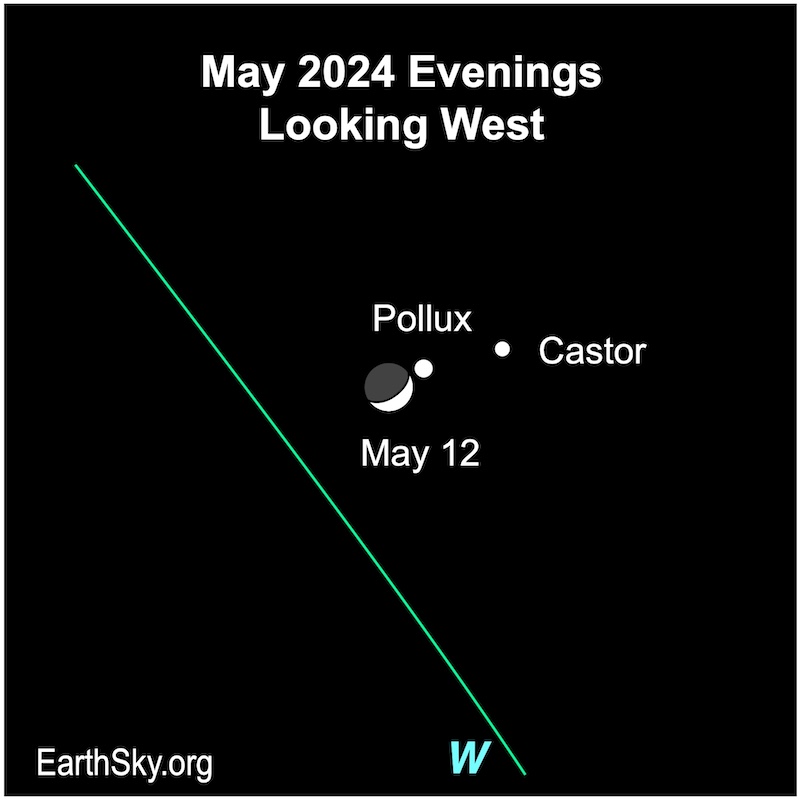
May 13 evening: Moon near Pollux and Castor and close to the Beehive
The thick waxing crescent moon will lie near M44, the Beehive star cluster, on the evening of May 13, 2024. You’ll need binoculars to spot dozens of the stars in the Beehive. Also nearby will be the bright twin stars of Gemini: Pollux and Castor. You can see them until around midnight.
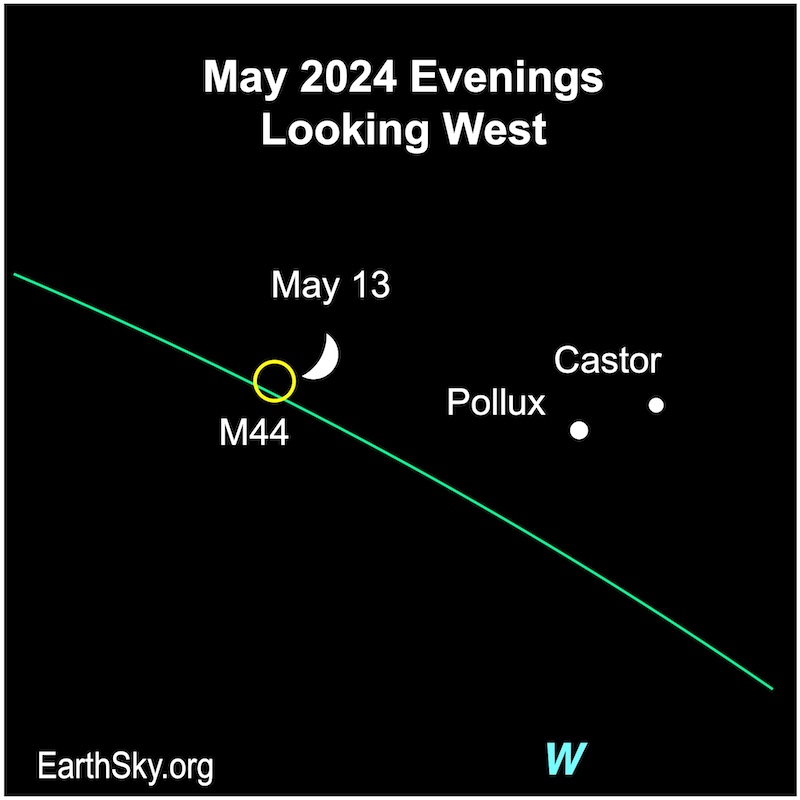
May 13 evening: Moon near Beehive binocular view
Through binoculars, two dozen stars can be spotted in the Beehive. The moon will glow in the binocular field’s upper right. This lovely open star cluster contains around 1,000 stars. The Beehive is located in the constellation of Cancer the Crab.
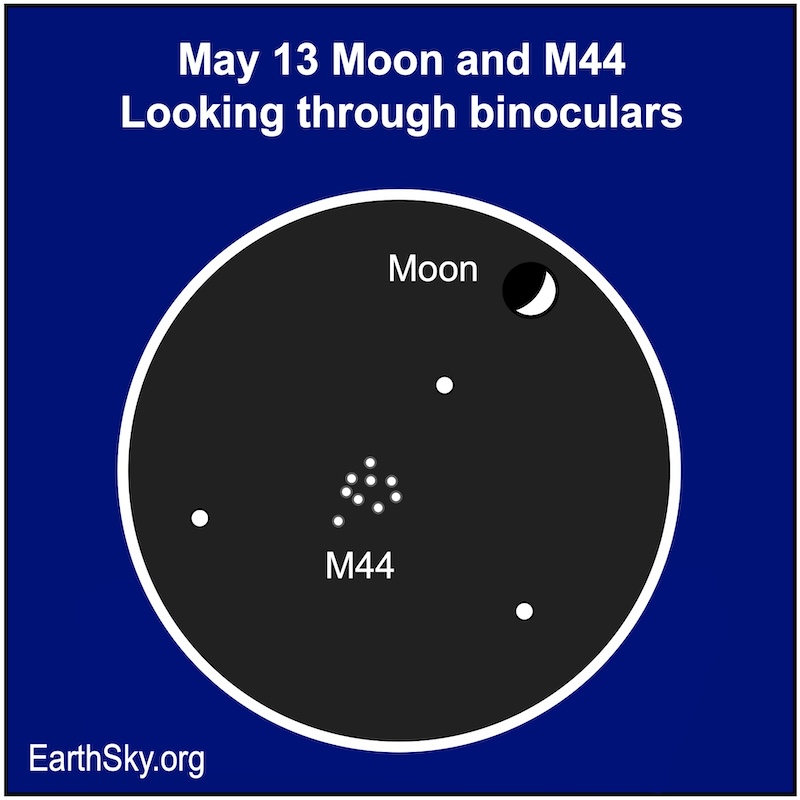
May 15: 1st quarter moon
The instant of 1st quarter moon will fall at 11:48 UTC on May 15, 2024 (6:48 a.m. CDT). A 1st quarter moon rises around noon your local time and sets around midnight. Watch for it high in the sky at sundown.
Our charts are mostly set for the northern half of Earth. To see a precise view – and time – from your location, try Stellarium Online.
May 15 evening: Moon near Regulus
On the evening of May 15, 2024, the 1st quarter moon will hang near the bright star Regulus, the brightest star in Leo the Lion. They’ll be visible through a few hours after midnight.
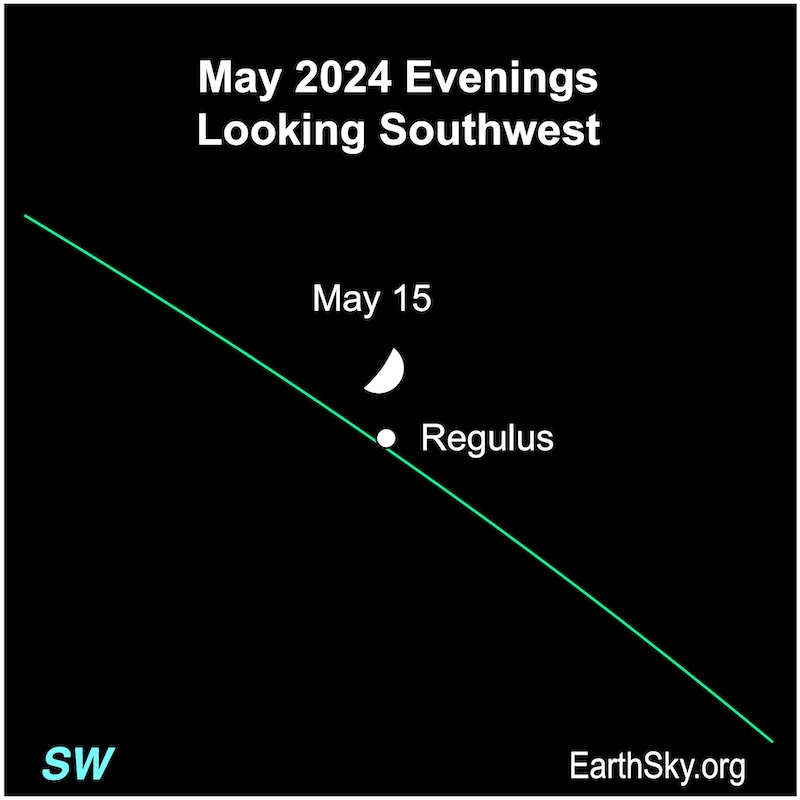
May 17: Moon reaches apogee
The moon will reach apogee – its farthest distance from Earth in its elliptical orbit around Earth – at 19 UTC (2 p.m. CDT) on May 17, 2024, when it’s 251,431 miles (404,640 kilometers) away.
May 18: Jupiter in conjunction with the sun
Jupiter will lie on the opposite side of the sun from Earth on May 18, 2024, and can’t be seen. This point in its orbit is called superior conjunction.
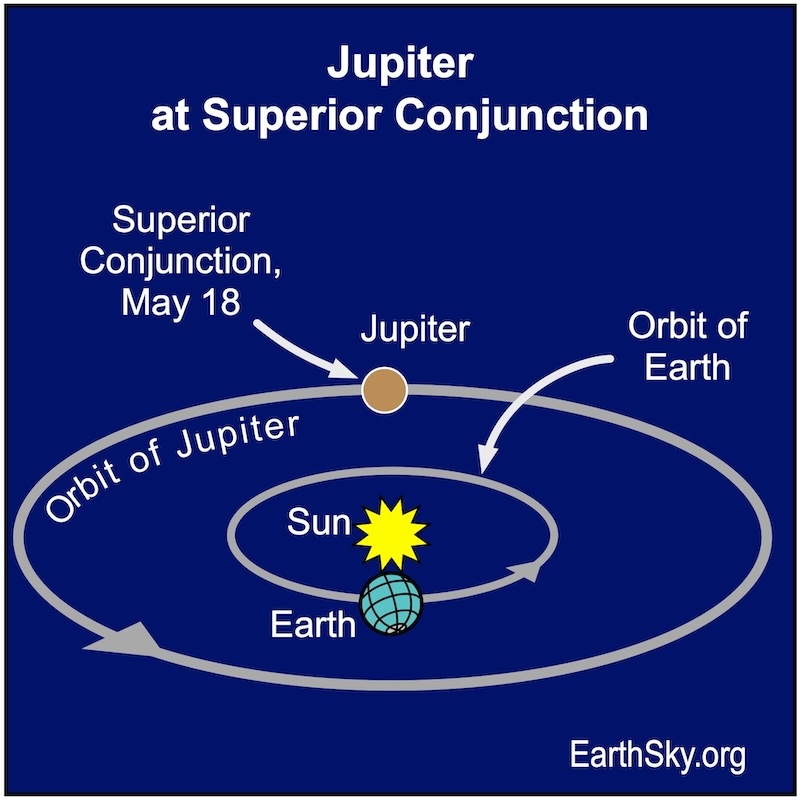
May 19 and 20 evenings: Moon near Spica
On the evenings of May 19 and 20, 2024, the fat waxing gibbous moon will hang near the bright star Spica in Virgo the Maiden. They’ll rise before sunset and be visible through several hours after midnight.
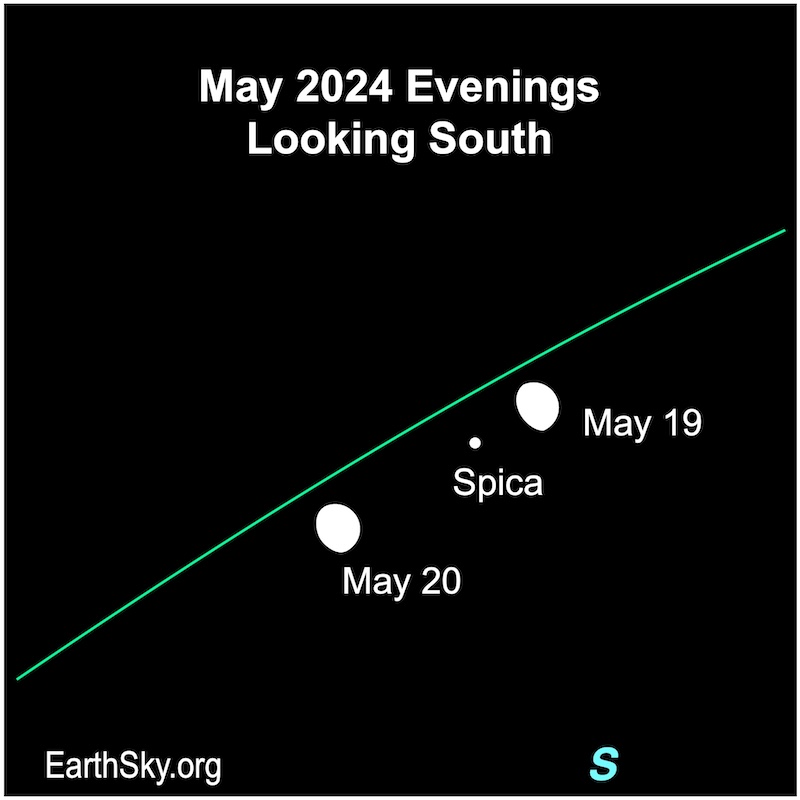
May 22 evening: Moon near Antares
On the evening of May 22, 2024, the waxing gibbous moon will lie near the bright red star Antares in Scorpius the Scorpion. They’ll be visible from early morning until dawn.
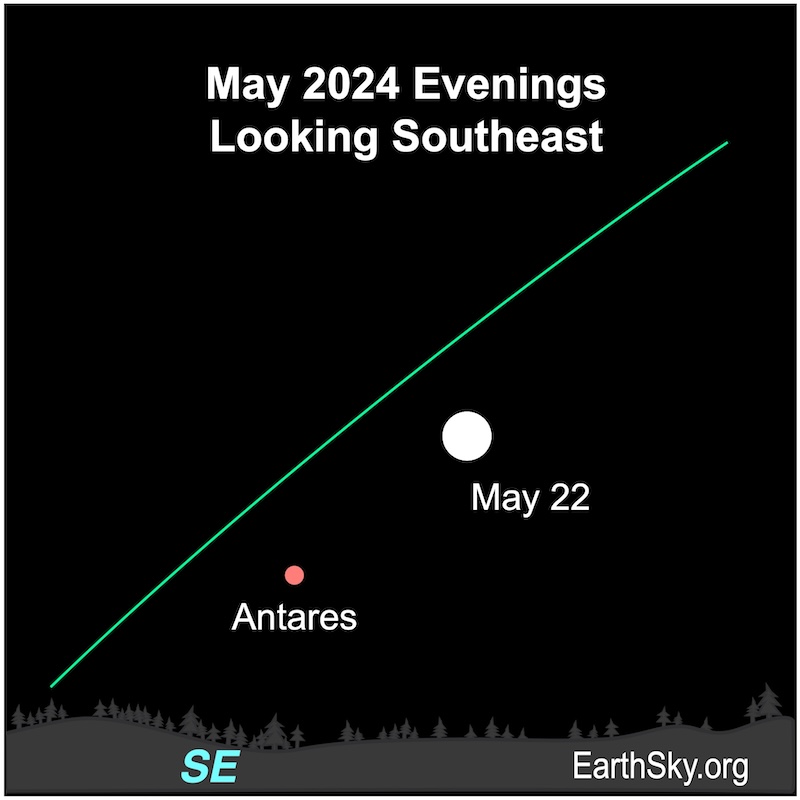
Our charts are mostly set for the northern half of Earth. To see a precise view – and time – from your location, try Stellarium Online.
May 23: Full moon
The full moon will occur at 13:53 UTC (8:53 a.m. CDT) on May 23, 2024. It’ll be visible all night.
May 23: Full moon close to Antares
On May 23, 2024, the bright red star Antares in Scorpius the Scorpion will lie close to the full moon. Full moon occurs at 13:53 UTC (8:53 a.m. CDT) on May 23, 2024. It’ll be visible all night. Also, sky watchers in the Americas, Western Africa and Middle Africa will see the moon pass in front of – or occult – Antares near 3 UTC on May 24. Other locations may see Antares very close to the limb of the moon.
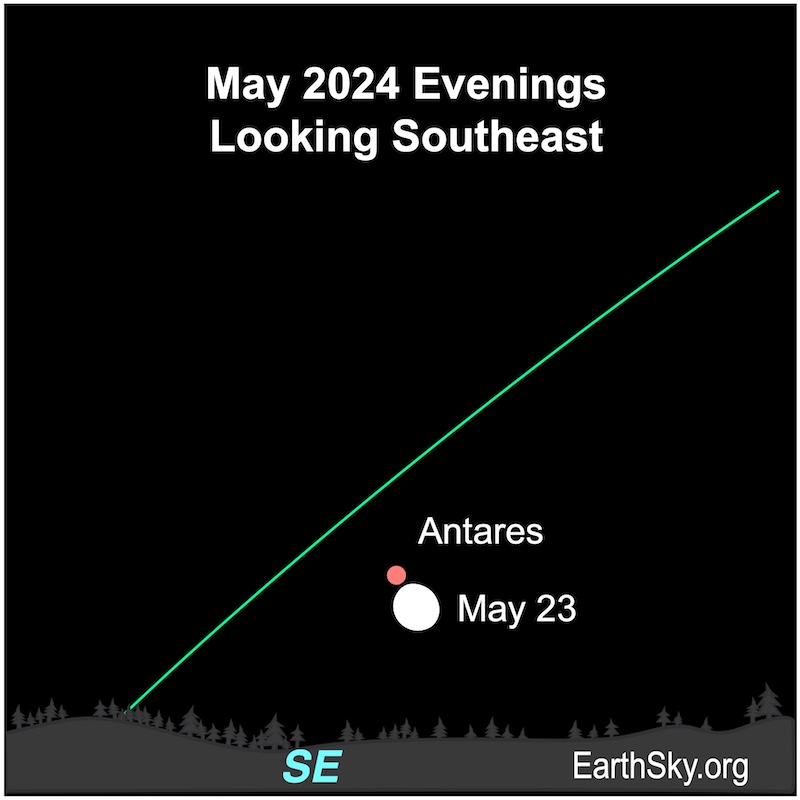
Our charts are mostly set for the northern half of Earth. To see a precise view – and time – from your location, try Stellarium Online.
May 30: Last quarter moon
The instant of last quarter moon will fall at 17:13 UTC on May 30, 2024 (12:13 p.m. CDT). It’ll rise after midnight your local time and will set around noon. Look for it high in the sky before dawn.
Our charts are mostly set for the northern half of Earth. To see a precise view – and time – from your location, try Stellarium Online.
May 31 morning: Moon visits Saturn
In the early morning hours of May 31, 2024, the moon will hang very close to Saturn. Also, sky watchers in parts of Argentina, Chile, Brazil and Uruguay among others will see the moon pass in front of – or occult – Saturn near 8 UTC on May 31.
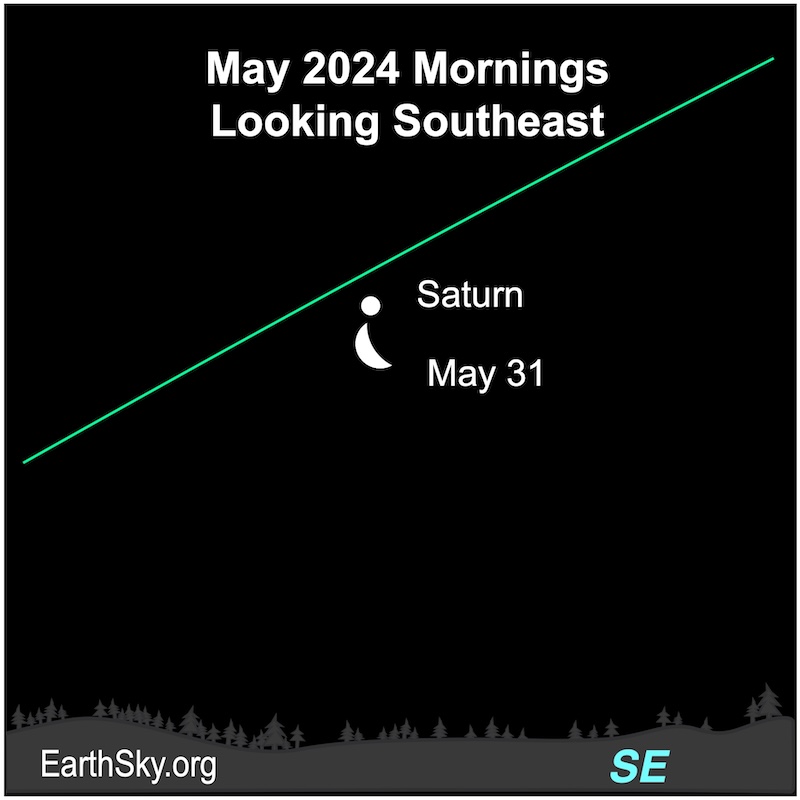
The Bears and the Dippers
Ursa Major the Great Bear is home to the Big Dipper. The Big Dipper is an asterism – a well-known group of stars – not an official constellation. You’ll find the Big Dipper high overhead from mid-northern latitudes in the May evening skies. You can use the Big Dipper to find many stars and constellations. One important star to locate is Polaris, the Pole Star or North Star. The 2 outer stars – Dubhe and Merak known as The Pointers – in the bowl of the Dipper point to Polaris. Polaris marks the end of the handle of the Little Dipper. The Little Dipper is part of Ursa Minor the Lesser Bear.
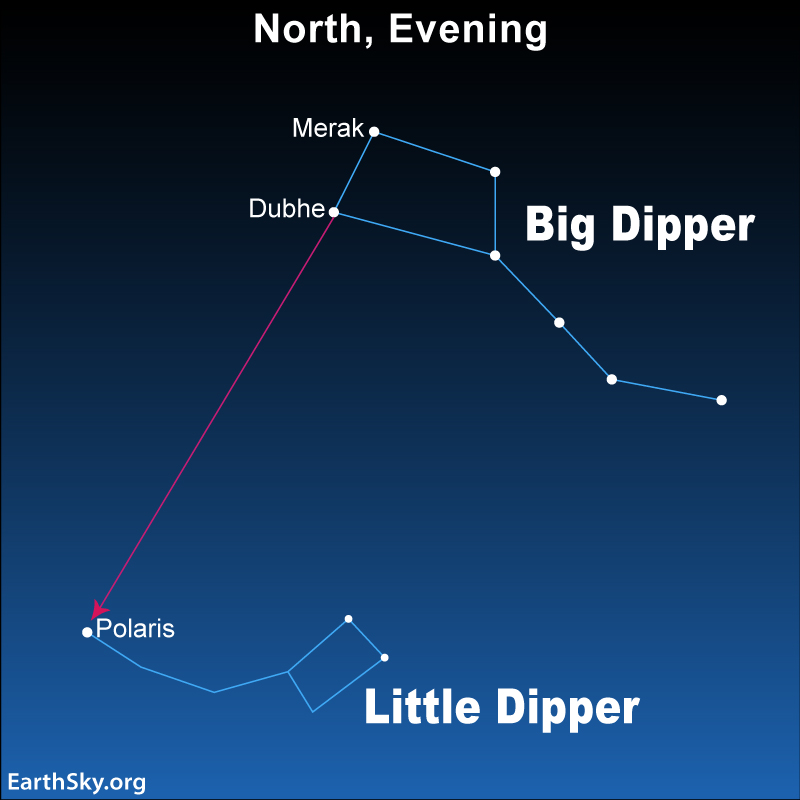
Leo the Lion
Next, you can use the Big Dipper to locate Leo the Lion. Draw an imaginary line southward from the pointer stars in the Big Dipper – the two outer stars in the Dipper’s bowl – to point toward Leo the Lion. The brightest star in Leo is Regulus. Under darker skies, you’ll see Regulus is the punctuation mark of a backward question mark pattern of stars. That is known as the Sickle. It’s also an asterism and part of Leo the Lion.
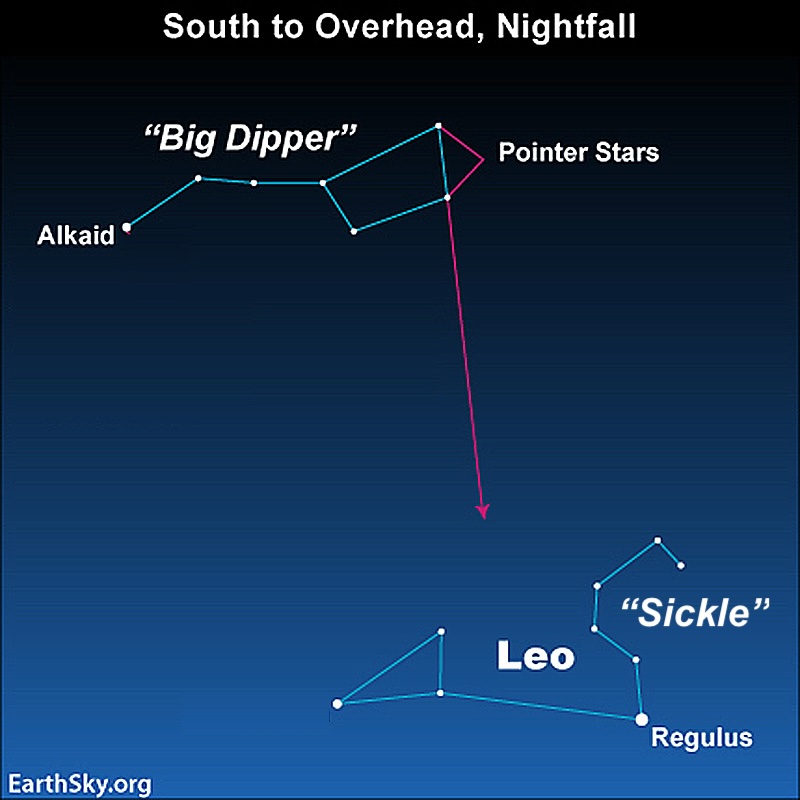
Arcturus and Spica
You can also use the Big Dipper to locate the bright star stars Arcturus and Spica. Many stargazers know this mnemonic arc to Arcturus, and speed on to Spica.

Boötes the Herdsman
Arcturus is in the constellation Boötes the Herdsman. Boötes has the shape of a kite, and Arcturus is at the point where you’d attach a tail. You can see it on spring evenings in the Northern Hemisphere.
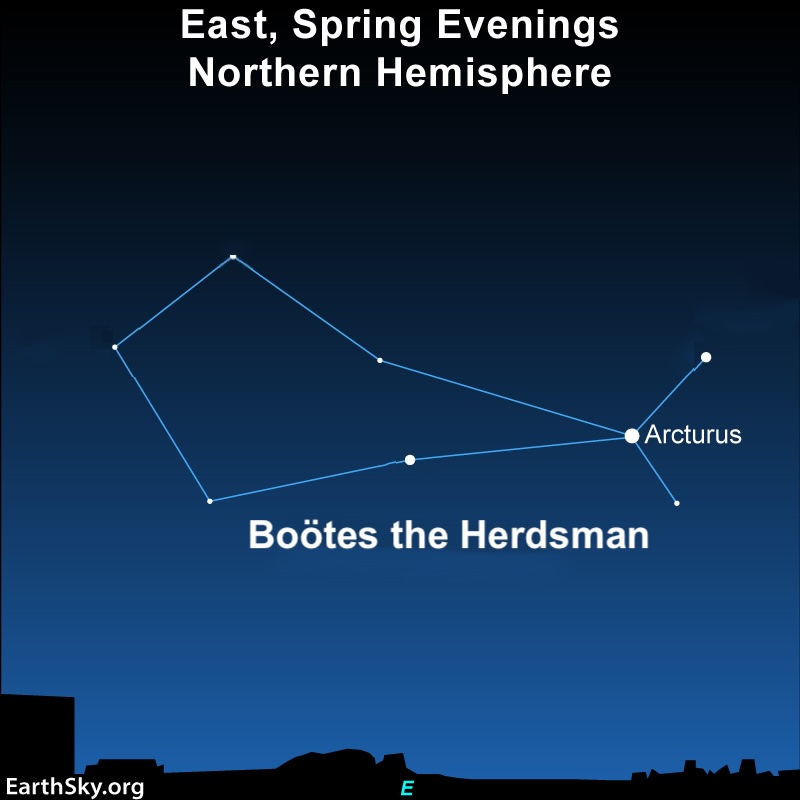
Virgo the Maiden
The constellation Virgo the Maiden is easy to find by using the handle of the Big Dipper to arc to Arcturus in Boötes, then speeding on (spiking down) to Spica, Virgo’s brightest star.
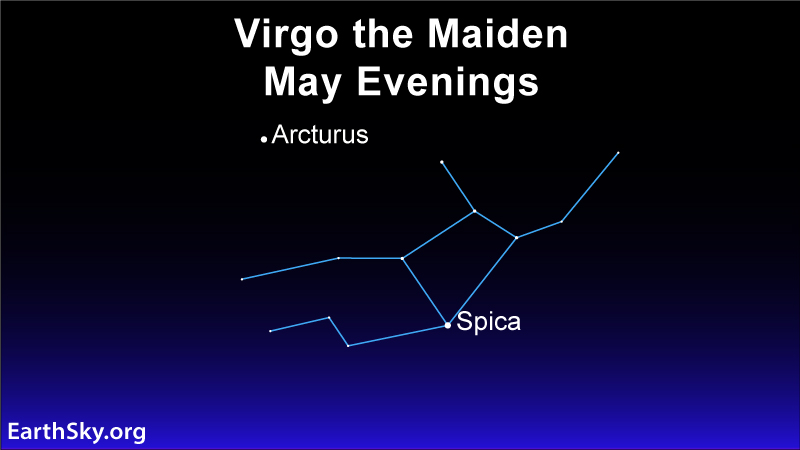
Have fun exploring the sky!
April evenings: Jupiter
Jupiter appears low in the west shortly after sunset in the first three weeks of April. During the month’s final week, it lies too low in the bright evening twilight to be easily seen. At the beginning of the month, Jupiter sets about three hours after sunset. At month’s end, Jupiter lies low in the evening twilight and may be challenging to spot. Jupiter will lie near the delicate Pleiades star cluster.
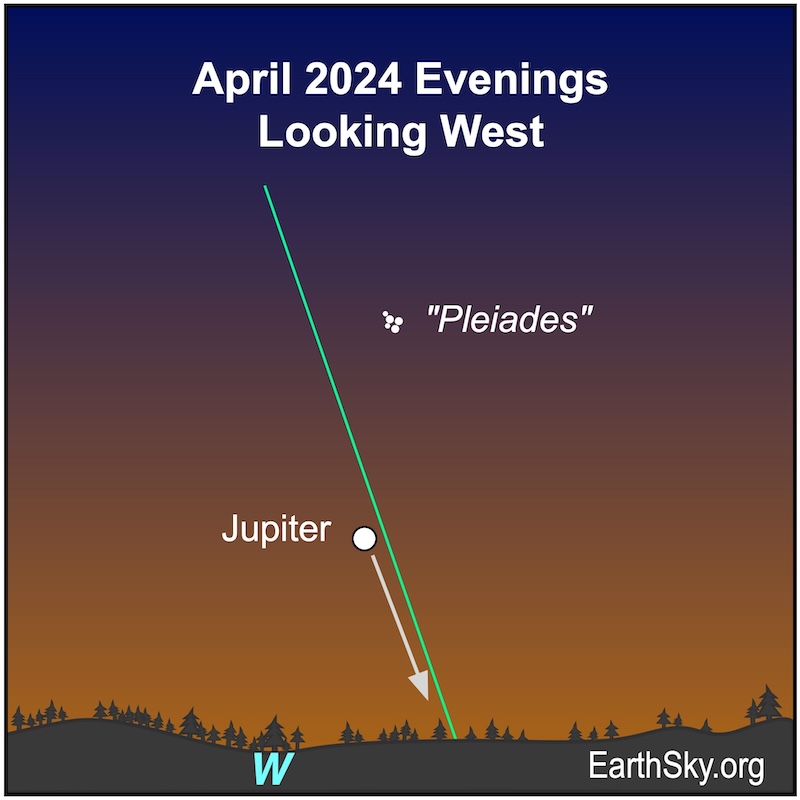
April mornings: Mars and Saturn
Mars and Saturn lie low in the morning twilight in April 2024. They shine with similar brightness and have a close pairing on the mornings of April 10 and 11. Saturn will climb a bit higher as the month goes on, and Mars will not move as much on the sky’s dome. By month’s end, Saturn will rise about two hours before sunrise and Mars will follow it about an hour later. Both planets will be easier to find in the coming months as they climb out of the morning glare.
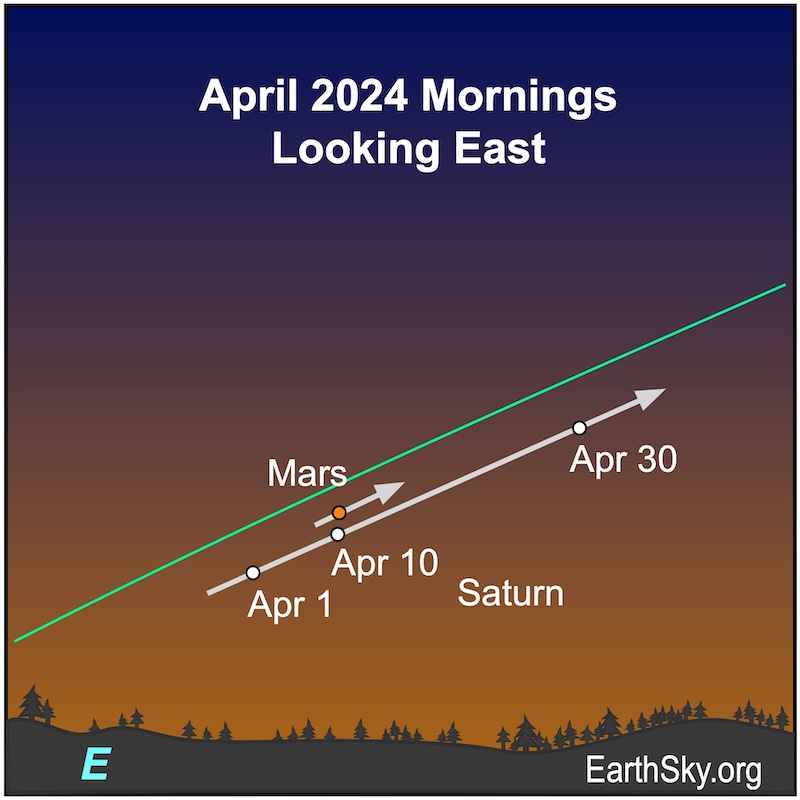
Where’s Venus and Mercury in April?
Venus is too close to the sun to be visible this month, and it’ll emerge in the evening sky around the beginning of August. Mercury will disappear from the bright evening twilight at the beginning of April and return to the morning sky in May.
May morning planets
In May 2024, Mars will shine at magnitude 1.1, and its disk will reach 5 arc minutes diameter by month’s end. It’ll have a close visit from the waning crescent moon on May 4 and 5, 2024. An occultation on May 4 will be visible in areas including Madagascar, Mauritius, Reunion and Seychelles, among others. Mars spends the month in the dim constellation of Pisces the Fish. It’ll rise about 90 minutes before the sun on May 1 and will rise about two hours before the sun by month’s end.
Saturn begins and ends the month of May with close passes from the moon. They’ll pair up on May 3 and 31. And occultations are visible in the Southern Hemisphere on both May 3 and May 31. Saturn will be dimming slightly in May because its ring system is closing – they’ll be edge-on in 2025 – and it’s getting farther from Earth. You can still notice an interesting comparison – in color and brightness – between Saturn and Mars throughout May. However, the two planets will grow farther apart as the month passes. Saturn spends the month in the faint constellation of Aquarius the Water Bearer. It’ll rise about two hours before the sun on May 1 and will rise about three hours before the sun by month’s end.
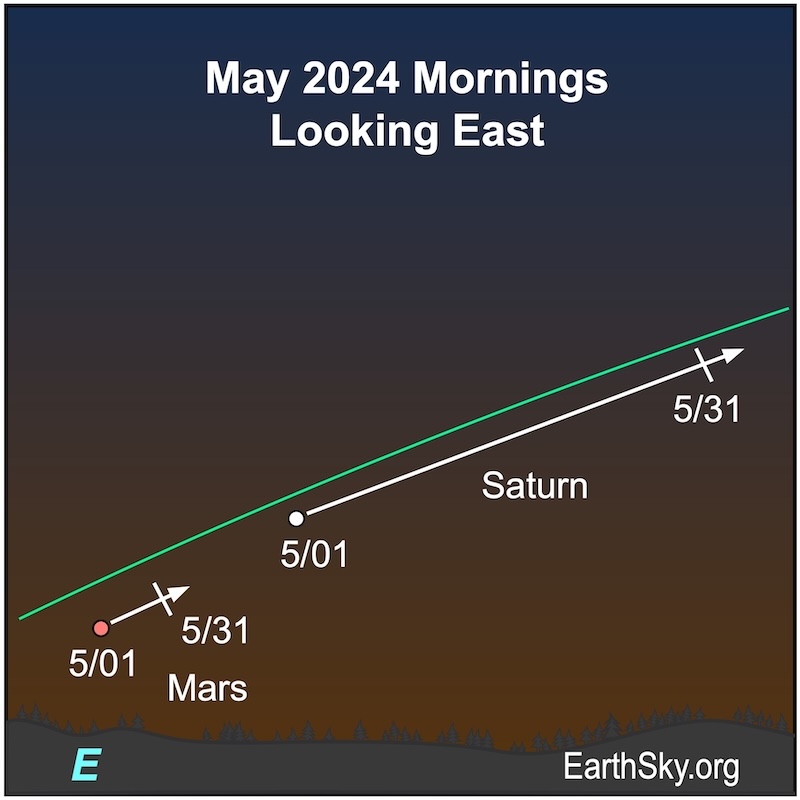
Mercury climbs higher further from the morning sun through May 9, 2024, when it reaches its greatest morning elongation and is 26 degrees from the sun. It’ll be shining at magnitude 0.6. It’ll continue to brighten a bit for the rest of the month until it slips from view. This will be the best morning apparition of 2024 for Southern Hemisphere observers. Mercury spends most of its time this month in the dim constellation of Pisces the Fish. It’ll rise about 45 minutes before the sun on May 1 and will rise about 30 minutes before the sun by month’s end. You might also spot Mars higher in the sky in the morning twilight.
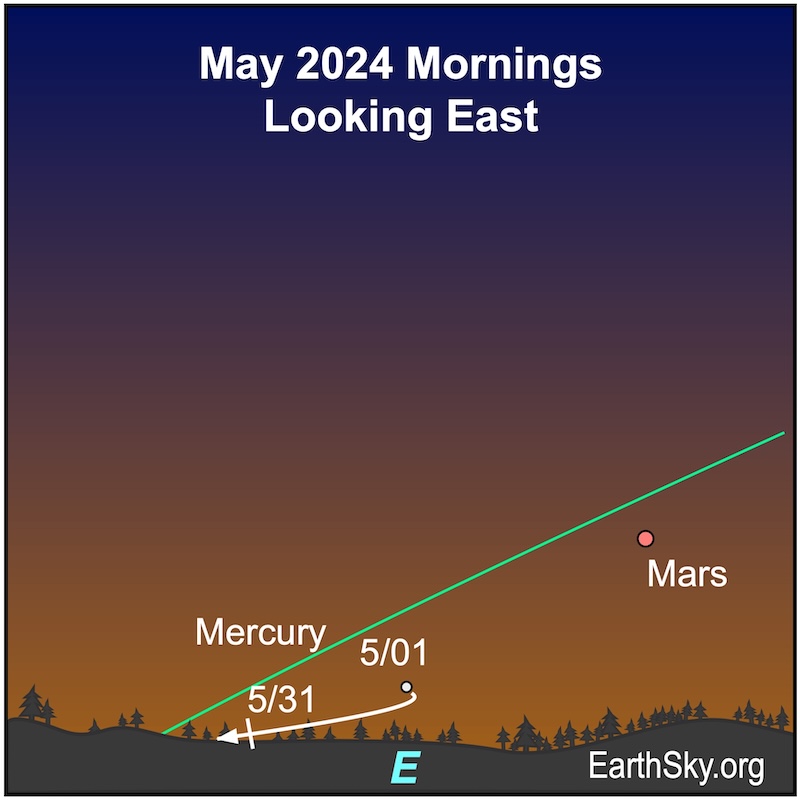
Where are Venus and Jupiter?
Both Venus and Jupiter are too close to the sun to be visible this month. Venus will emerge in the evening sky around the beginning of August. And Jupiter will emerge in the morning sky by early August.
Our charts are mostly set for the northern half of Earth. To see a precise view – and time – from your location, try Stellarium Online.
Thank you to all who submit images to EarthSky Community Photos! View community photos here. We love you all. Submit your photo here.
Looking for a dark sky? Check out EarthSky’s Best Places to Stargaze.
Sky dome maps for visible planets and night sky
The sky dome maps come from master astronomy chart-maker Guy Ottewell. You’ll find charts like these for every month of 2024 in his Astronomical Calendar.
Guy Ottewell explains sky dome maps
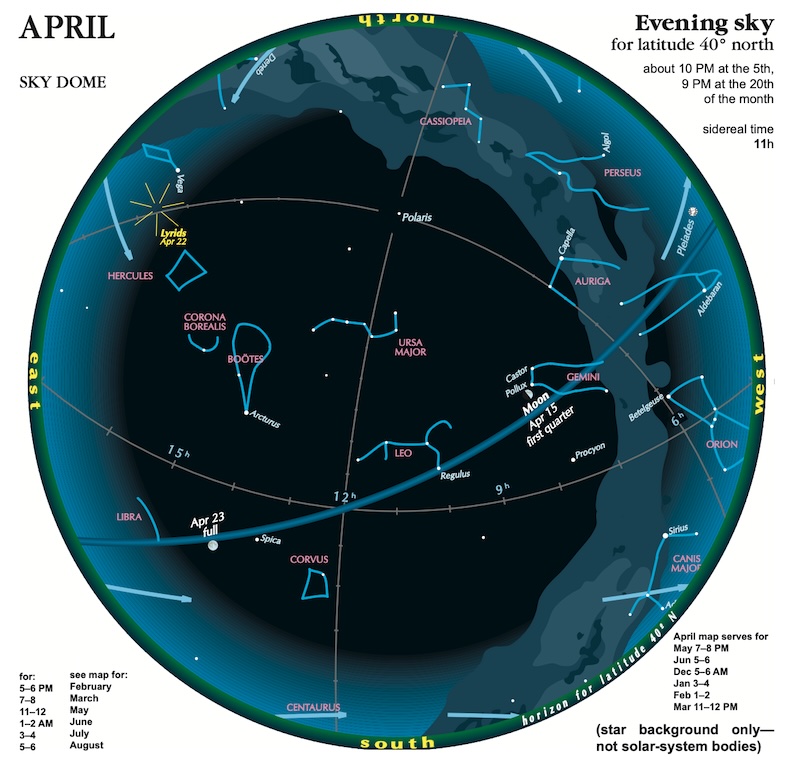
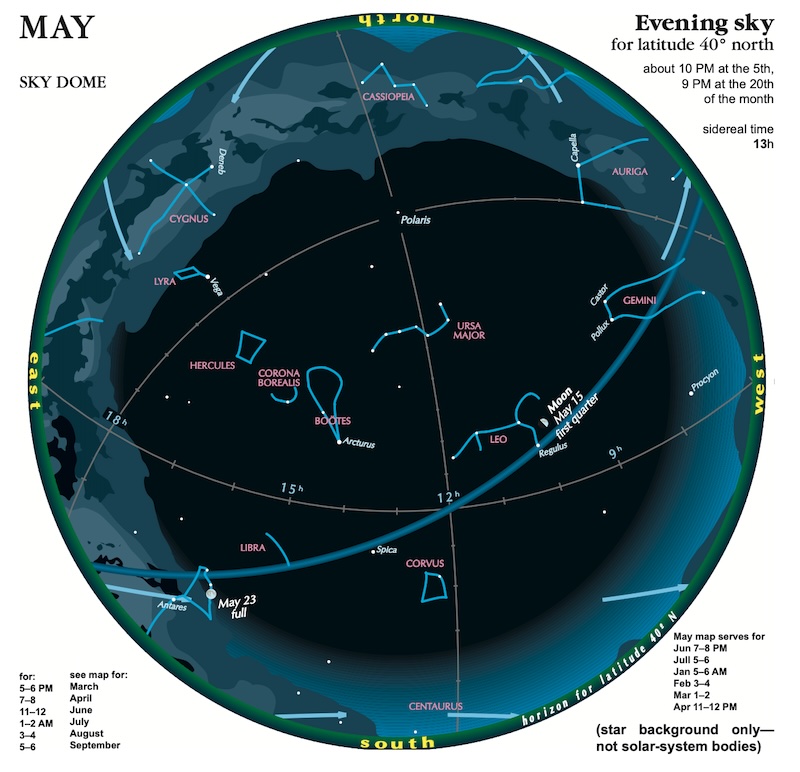
Heliocentric solar system visible planets and more
The sun-centered charts come from Guy Ottewell. You’ll find charts like these for every month of 2024 in his Astronomical Calendar.
Guy Ottewell explains heliocentric charts.

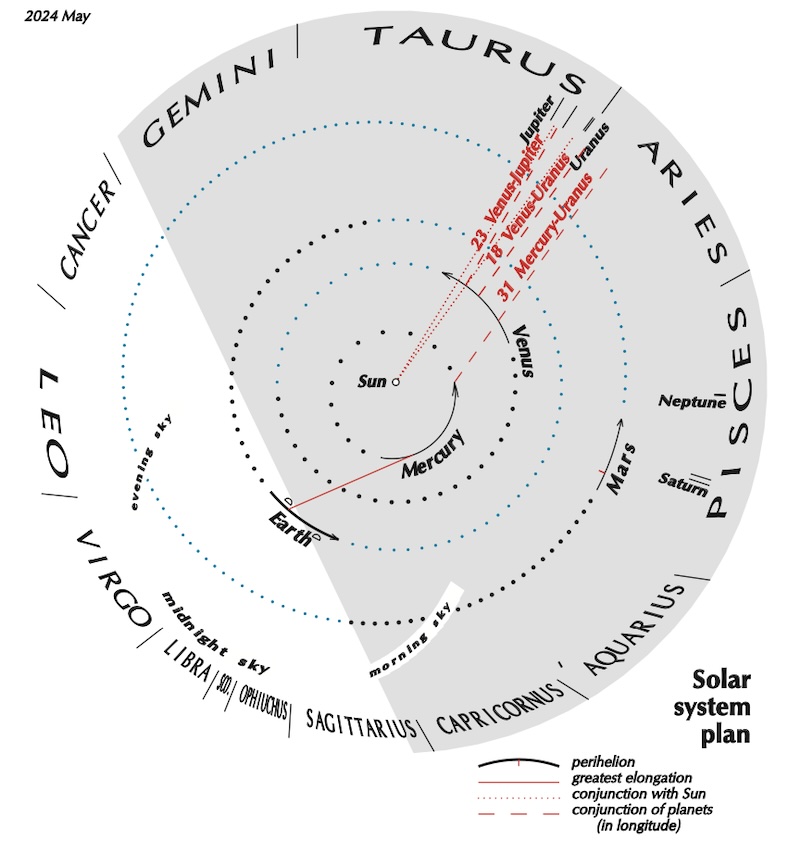
Some resources to enjoy
For more videos of great night sky events, visit EarthSky’s YouTube page.
Watch EarthSky’s video about Two Great Solar Eclipses Coming Up
Don’t miss anything. Subscribe to daily emails from EarthSky. It’s free!
Visit EarthSky’s Best Places to Stargaze to find a dark-sky location near you.
Post your own night sky photos at EarthSky Community Photos.
Translate Universal Time (UTC) to your time.
See the indispensable Observer’s Handbook, from the Royal Astronomical Society of Canada.
Visit Stellarium-Web.org for precise views from your location.
Almanac: Bright visible planets (rise and set times for your location).
Visit TheSkyLive for precise views from your location.
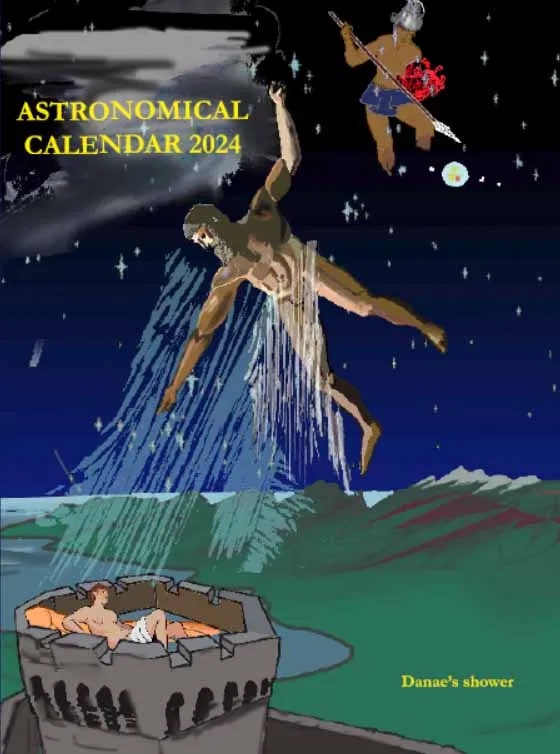
Bottom line: Visible planets and night sky guide for April 2024. On the mornings of April 26 and 27, watch for the moon close to the bright star Antares in Scorpius the Scorpion.











